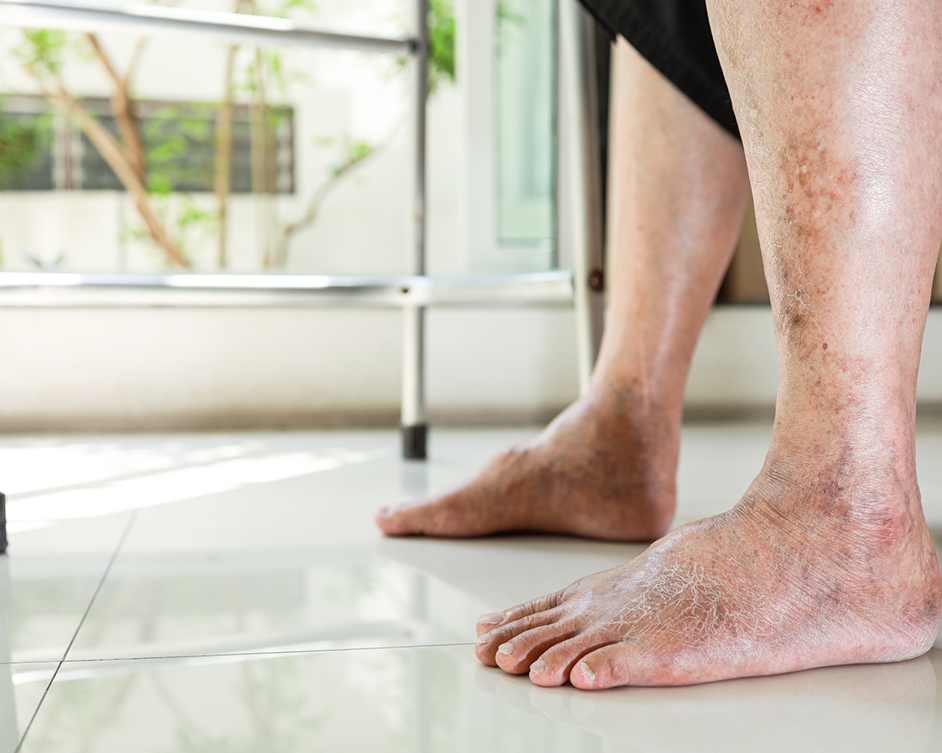Peripheral Vascular Disease
What is Peripheral Vascular Disease (PVD)?
Peripheral Vascular Disease (PVD) is a disorder of the blood vessels, a circulatory condition that occurs when blood flow to your 4 limbs(typically your arms and legs) is reduced.
What is the main cause of peripheral artery disease? This happens due to narrowed or blocked blood vessels not just in arms and legs, PVD can affect any blood vessel located outside of the heart. This includes arteries, veins, and lymphatic vessels. When these blood vessels are narrowed or blocked, the organs they supply, even the brain, may not receive adequate blood flow, leading to various health issues.
Is PVD the Same as PAD?
Peripheral Vascular Disease (PVD) in Dubai
The prevalence of peripheral vascular disease (PVD) in Dubai is a growing concern. Dubai ‘s diverse population, including expatriates from various regions with different health profiles, contributes to the complexity of PVD cases in the country. Early detection and proper management of PVD are crucial for preventing severe complications and improving the quality of life for affected individuals.
Given the growing awareness of cardiovascular health and the increasing focus on preventive care in Dubai, early detection and management of PAD are crucial for improving the overall health and well-being of the population.

What Causes Peripheral Vascular Disease?
The primary cause of PVD is atherosclerosis, a condition where plaque (a build-up of fatty substances) forms inside your arteries, decreasing the oxygen and nutrients sent to the tissue. As this plaque accumulates, it narrows the arteries, reducing blood flow to your limbs. Other factors, such as blood clots or inflammation, can also contribute to PVD.
Other causes of PVD may include:
- Arm or leg injuries
- Infections
- Irregular anatomy
- Muscles or ligaments
Who is at Risk for Peripheral Vascular Disease?
Several factors increase your risk of developing PVD, including
Age: older adults are at higher risk
Smoking
Diabetes
High blood pressure
High cholesterol levels
Obesity
Sedentary lifestyle
Family history of PVD or other circulatory conditions
What are the Symptoms of Peripheral Vascular Disease?
What are the signs of vascular disease? Symptoms of PVD can vary depending on the severity of the condition. Common symptoms include
The most common symptom is pain, which becomes worse as the circulation is more limited.
Leg cramping, especially when walking
Numbness or tingling in the legs or feet
Weak pulses in the legs or feet
Cold extremities
Skin sores that heal slowly or not at all
Changes in skin color or texture
Erectile dysfunction (in men)
What Does Peripheral Vascular Disease Look Like in The Legs?
Skin changes
Shiny, hairless skin, discoloration, or sores that don’t heal.
Swelling
Accumulation of fluid in the legs.
Varicose veins
Leg ulcers
Open sores that are difficult to heal.
Color changes
Stages of Peripheral Artery Disease (PAD)
To assess the severity of peripheral artery disease (PAD), healthcare providers use classification systems to stage the condition. Two common systems are the Fontaine and Rutherford classifications.
The Fontaine stages, a simpler system, categorize PAD as follows
Stage I
Stage IIa
Mild claudication – Leg pain occurs during exercise.
Stage IIb
Moderate to severe claudication – Leg pain significantly limits daily activities.
Stage III
Ischemic rest pain – Leg pain occurs even while resting.
Stage IV
Tissue loss or gangrene – Severe lack of blood flow leading to tissue damage.
General FAQs
Your healthcare provider will conduct a physical exam and may order tests to diagnose PVD, including:
- Ankle-brachial index (ABI): Compares blood pressure in your arms and ankles.
- Doppler ultrasound: Uses sound waves to assess blood flow.
- Angiography: Uses X-ray imaging to visualize blood vessels.
If left untreated, PVD can lead to serious complications, such as:
- Peripheral arterial disease (PAD): A more severe form of PVD
- Critical limb ischemia (CLI): Severely reduced blood flow to the limbs
- Aneurysm: A bulge in a blood vessel wall
- Heart attack or stroke
- Gangrene: Tissue death due to lack of blood flow
When lifestyle modifications and medications are not sufficient to manage PVD, minimally invasive or surgical treatments may be necessary. These procedures aim to restore blood flow and prevent disease progression to the affected limbs:
- Angioplasty and Stenting: A minimally invasive procedure involving the insertion of a thin tube (catheter) with a balloon at its tip into the blocked artery. The balloon is inflated to widen the artery, and a stent (a small, mesh tube) is often deployed to prevent re-narrowing.
- Atherectomy: This procedure employs a specialized device to remove plaque buildup from the artery walls, improving blood flow.
- Bypass Surgery: A more invasive procedure that involves creating new pathways for blood to bypass blocked areas. This is typically performed when multiple blockages are present or when angioplasty and stenting are not feasible.
While there’s no cure for peripheral artery disease (PAD), its progression can often be slowed, and in some cases, its symptoms are reversed. By adopting a heart-healthy lifestyle, including regular exercise, a balanced diet, and managing conditions like diabetes and high blood pressure, individuals with PAD can improve blood flow and reduce symptoms. Early detection and treatment are crucial for preventing the disease from worsening. It’s essential to consult with a healthcare professional for personalized guidance and management
- Quitting smoking
- Regular exercise
- Maintaining a healthy weight
- Eating a balanced diet
- Managing blood pressure and cholesterol levels
- Regular check-ups
PAD and Amputation
In severe cases of peripheral artery disease where blood flow to the limbs becomes critically compromised, amputation may become a last choice. This drastic measure is typically considered when other treatment options, such as angioplasty, bypass surgery, or medication, have failed to restore adequate blood flow.
Critical limb ischemia (CLI) is a severe stage of PAD that significantly increases the risk of amputation. CLI occurs when the blood supply to the limbs is so reduced that it cannot meet the basic metabolic needs of the tissue. This leads to tissue damage and potentially life-threatening infections. Preventing amputation is a primary goal in PAD management. Early detection, aggressive risk factor management, and timely intervention can significantly reduce the risk of limb loss. Contact a vascular specialist or cardiologist at the earliest sign of PVD symptoms to initiate prompt diagnosis and treatment.
To read more about PAD, visit this link.
Why Choose Coronary Artery Disease Treatment in Dubai?
Expertise
Dr. Mazen brings a wealth of experience and specialized knowledge in diagnosing and treating complex structural heart conditions all the way from the United States to Dubai.
Personalized Care
Advanced Technology
Minimally invasive procedures for optimal outcomes.
Compassionate Care
A supportive and patient-centered approach throughout your treatment journey.
Proven Results
Secure Your Path to Better Heart Health!

